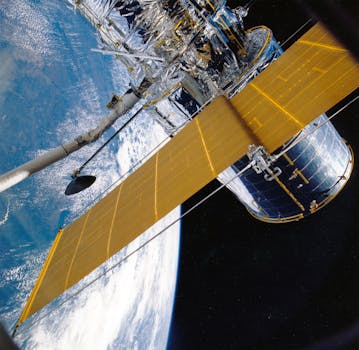Harnessing the Skies: New Technologies Transforming Satellite Communications
The satellite communications industry is undergoing a significant transformation with the advent of new technologies, including advanced satellite designs, launch systems, and ground equipment. This transformation is enabling faster, more reliable, and more secure satellite communications, which are essential for a wide range of applications, including telecommunications, navigation, and Earth observation.

Harnessing the Skies: New Technologies Transforming Satellite Communications
Harnessing the Skies: New Technologies Transforming Satellite Communications is revolutionizing the way we communicate and access information. The satellite communications industry is undergoing a significant transformation with the advent of new technologies, including advanced satellite designs, launch systems, and ground equipment. This transformation is enabling faster, more reliable, and more secure satellite communications, which are essential for a wide range of applications, including telecommunications, navigation, and Earth observation.
The development of new satellite technologies, such as high-throughput satellites (HTS) and very high-throughput satellites (VHTS), is enabling the provision of higher-speed and lower-latency satellite communications services. These satellites use advanced technologies, such as beam-forming and frequency reuse, to achieve higher capacities and improve the overall efficiency of satellite communications systems. Additionally, the use of advanced materials and manufacturing techniques is enabling the development of smaller, more efficient, and more cost-effective satellites, which are ideal for constellations and other applications where multiple satellites are required.
Advances in Launch Systems
Advances in launch systems are also playing a crucial role in the transformation of the satellite communications industry. The development of reusable launch vehicles, such as those being developed by SpaceX and Blue Origin, is reducing the cost of launching satellites into orbit. This is enabling more satellites to be launched, which is driving the growth of satellite constellations and other applications that require multiple satellites. Furthermore, the use of advanced launch systems, such as electric propulsion, is enabling satellites to be placed into orbit more efficiently and with greater precision.
The development of new launch systems is also enabling the launch of smaller satellites, which are ideal for applications where size and weight are limited. For example, the development of small launch vehicles, such as the Rocket Lab Electron, is enabling the launch of small satellites into low Earth orbit (LEO) and other orbits. This is driving the growth of the small satellite market, which is expected to play a significant role in the future of satellite communications.
Ground Equipment and Networking
Advances in ground equipment and networking are also essential for the transformation of the satellite communications industry. The development of new ground equipment, such as phased arrays and active antennas, is enabling the provision of higher-speed and lower-latency satellite communications services. These systems use advanced technologies, such as beam-forming and frequency hopping, to achieve higher capacities and improve the overall efficiency of satellite communications systems.
The development of software-defined networking (SDN) and network function virtualization (NFV) is also playing a crucial role in the transformation of the satellite communications industry. These technologies are enabling the creation of more flexible and scalable satellite communications networks, which can be easily customized to meet the needs of different applications and users. Additionally, the use of advanced encryption and security technologies is enabling the provision of more secure satellite communications services, which are essential for applications where security is a top priority.
Applications and Future Directions
The transformation of the satellite communications industry is enabling a wide range of applications, including telecommunications, navigation, and Earth observation. For example, the development of satellite-based telecommunications systems is enabling the provision of broadband services to remote and underserved communities. Additionally, the use of satellite-based navigation systems, such as GPS and Galileo, is enabling the provision of precise location and timing information, which is essential for a wide range of applications, including aviation, maritime, and land transportation.
The future of satellite communications is expected to be shaped by a number of factors, including advances in technology, changes in market demand, and the development of new applications and services. For example, the development of quantum communications and other advanced technologies is expected to play a significant role in the future of satellite communications. Additionally, the growth of the Internet of Things (IoT) and other applications is expected to drive the demand for satellite communications services, particularly in areas where terrestrial connectivity is limited or non-existent.






